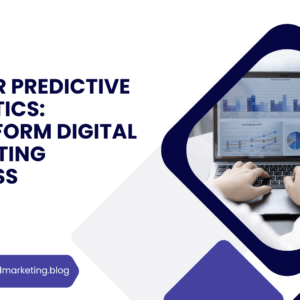Introduction
In the ever-evolving digital landscape, staying ahead of the competition is a marketer’s ultimate goal. Predictive analytics in digital marketing is revolutionizing how businesses understand their audience, refine campaigns, and achieve measurable results. By leveraging data, patterns, and AI-driven insights, marketers can predict future behaviors and create strategies that resonate.
In this blog, we’ll dive deep into how predictive analytics works, its applications in digital marketing, and actionable tips to implement it effectively. Let’s transform your digital marketing strategy!

Table of Contents
What is Predictive Analytics in Digital Marketing?
Predictive analytics uses historical data, statistical algorithms, and machine learning techniques to forecast future outcomes. For digital marketing, it means predicting consumer behaviors, trends, and campaign performances.
With tools like Google Analytics, Salesforce Einstein, and Adobe Analytics, businesses can gather actionable insights to:
- Identify audience preferences.
- Forecast sales trends.
- Enhance customer segmentation.
Example: A retail eCommerce brand might analyze purchase histories and seasonal trends to predict which products will be in demand, tailoring their marketing efforts accordingly.

Why Predictive Analytics is a Game-Changer
Predictive analytics offers unique advantages for digital marketers:
- Improved ROI: Focus marketing spend on strategies proven to work.
- Enhanced Customer Experience: Personalize interactions based on predicted behaviors.
- Competitive Edge: Stay ahead of trends by forecasting them before they happen.
A study by Statista revealed that companies using predictive analytics experience a 20% higher ROI on marketing campaigns.
Key Applications of Predictive Analytics in Digital Marketing
1. Audience Segmentation and Targeting
Predictive analytics enables marketers to group customers based on shared characteristics and likely behaviors. This approach fosters highly targeted campaigns.
Case Study:
Netflix’s recommendation algorithm analyzes user data to predict preferences, suggesting shows or movies tailored to each viewer’s tastes. This strategy drives engagement and retention.
2. Predicting Customer Lifetime Value (CLV)
Identifying customers with the highest potential value allows businesses to prioritize their efforts effectively.
Real-World Example:
Amazon predicts CLV to decide which customers receive premium services, discounts, or promotional emails.
3. Optimizing Ad Campaigns
Predictive analytics helps refine ad targeting by forecasting which audiences are most likely to convert.
Graph: ROI Comparison Before and After Predictive Analytics Integration
(Include a bar graph showcasing ROI improvement after implementing predictive analytics in ad campaigns.)
4. Content Personalization
By understanding what content resonates with different audience segments, businesses can deliver highly personalized experiences.
Example: Spotify’s “Discover Weekly” playlist uses predictive analytics to curate music recommendations based on past listening habits.

Steps to Implement Predictive Analytics in Your Digital Marketing Strategy
1. Define Clear Goals
Identify what you want to achieve: better audience targeting, higher ROI, or increased engagement.
2. Collect and Clean Your Data
Ensure your data is comprehensive and free of errors. Tools like Tableau or Google Data Studio can assist in visualizing and cleaning data.
3. Choose the Right Tools
Leverage tools such as:
- Google Analytics 4: Tracks user behavior in real time.
- HubSpot: Offers predictive lead scoring for CRM.
- IBM Watson Studio: For advanced AI-powered insights.
4. Develop Predictive Models
Use machine learning algorithms to create models tailored to your goals.
5. Test and Optimize
Consistently evaluate the performance of your predictive models to ensure accuracy and relevance.
Overcoming Challenges in Predictive Analytics
While predictive analytics offers immense potential, marketers often face challenges such as:
- Data Silos: Ensure seamless integration across platforms.
- Privacy Concerns: Comply with GDPR and other data regulations.
- Skill Gaps: Invest in training your team to use predictive tools effectively.
Future Trends: Predictive Analytics and AI in Digital Marketing
As AI continues to evolve, predictive analytics will become even more powerful. Key trends to watch:
- Real-Time Predictive Insights: Tools will offer immediate predictions, enhancing agility in marketing.
- Voice Search Optimization: Predictive analytics will analyze voice search patterns for more targeted content strategies.
- Hyper-Personalization: Marketing will move from segmentation to one-on-one personalization at scale.
Case Study:
Coca-Cola uses AI-powered predictive analytics to determine which product innovations will resonate with different demographics, reducing market risks.

Conclusion
Incorporating predictive analytics in digital marketing isn’t just a trend—it’s a necessity. By understanding and anticipating customer needs, businesses can craft campaigns that don’t just meet but exceed expectations.
Stay ahead of the curve, make data-driven decisions, and elevate your digital marketing game today!
Would you like us to create a custom predictive analytics strategy for your business? Let’s connect!


Add a Comment